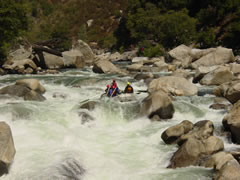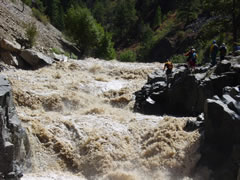River Classification System
International Scale of River Difficulty as defined by American Whitewater
Class I (easy): Fast moving water with riffles and small waves. The river has few obstructions which are all obvious and easily missed with little training. The risk to swimmers is slight and self-rescue is easy.
Class II (novice): Straightforward rapids with wide, clear channels which are evident without scouting. Occasional maneuvering may be required, but rocks and medium sized waves are easily missed by trained paddlers. Swimmers are seldom injured and group assistance, while helpful, is seldom needed. Rapids that are at the upper end of this difficulty range are designated "Class II+."
 Class III (intermediate): Rapids with moderate, irregular waves which
may be difficult to avoid and which can swamp an open canoe. Complex maneuvers
in fast current and good boat control in tight passages or around ledges
are often required. Large waves or strainers may be present but are easily
avoided. strong eddies and powerful current effects can be found, particularly
on larger volume rivers. Scouting is advisable for inexperienced parties.
Injuries while swimming are rare and self-rescue is usually easy but group
assistance may be required to avoid long swims. Rapids that are at the
lower or upper end of this difficulty range are designated "Class III-" or "Class III+" respectively.
Class III (intermediate): Rapids with moderate, irregular waves which
may be difficult to avoid and which can swamp an open canoe. Complex maneuvers
in fast current and good boat control in tight passages or around ledges
are often required. Large waves or strainers may be present but are easily
avoided. strong eddies and powerful current effects can be found, particularly
on larger volume rivers. Scouting is advisable for inexperienced parties.
Injuries while swimming are rare and self-rescue is usually easy but group
assistance may be required to avoid long swims. Rapids that are at the
lower or upper end of this difficulty range are designated "Class III-" or "Class III+" respectively.
 Class IV (advanced): Intense and powerful but predictable rapids requiring
precise boat handling in turbulent water. The rapids may feature large,
unavoidable waves and holes or constricted passages demanding fast maneuvers
under pressure. A fast and reliable eddy turn may be needed to initiate
maneuvers, scout rapids, or rest. Rapids may require mandatory moves above
dangerous hazards. Scouting is usually necessary the first time down.
The risk of injury to swimmers is moderate to high and water conditions
may make self-rescue difficult. Group assistance for rescue is often essential
and requires practiced skills. A strong eskimo roll is highly recommended
for kayakers. Rapids that are at the upper end of this difficulty range
are designated as "Class IV-" or "Class IV+" respectively.
Class IV (advanced): Intense and powerful but predictable rapids requiring
precise boat handling in turbulent water. The rapids may feature large,
unavoidable waves and holes or constricted passages demanding fast maneuvers
under pressure. A fast and reliable eddy turn may be needed to initiate
maneuvers, scout rapids, or rest. Rapids may require mandatory moves above
dangerous hazards. Scouting is usually necessary the first time down.
The risk of injury to swimmers is moderate to high and water conditions
may make self-rescue difficult. Group assistance for rescue is often essential
and requires practiced skills. A strong eskimo roll is highly recommended
for kayakers. Rapids that are at the upper end of this difficulty range
are designated as "Class IV-" or "Class IV+" respectively.
 Class V (expert): Extremely long, obstructed, or very violent rapids
which expose a paddler to added risk. Rapids may contain large, unavoidable
waves and holes or steep, congested chutes with complex, demanding routes.
Rapids may continue for long distances between pools, demanding a high
level of fitness. The eddies that exist may be small, turbulent, or difficult
to reach. More difficult Class V rapids may combine several of these factors.
Scouting is recommended and may be difficult. Swims are dangerous and
rescue is often difficult even for teams of experts. Proper equipment,
extensive experience, and practiced rescue skills are essential. There
is a large range of difficulty that exists beyond Class IV which makes
the difficulty of Class V rapids very diverse.
Class V (expert): Extremely long, obstructed, or very violent rapids
which expose a paddler to added risk. Rapids may contain large, unavoidable
waves and holes or steep, congested chutes with complex, demanding routes.
Rapids may continue for long distances between pools, demanding a high
level of fitness. The eddies that exist may be small, turbulent, or difficult
to reach. More difficult Class V rapids may combine several of these factors.
Scouting is recommended and may be difficult. Swims are dangerous and
rescue is often difficult even for teams of experts. Proper equipment,
extensive experience, and practiced rescue skills are essential. There
is a large range of difficulty that exists beyond Class IV which makes
the difficulty of Class V rapids very diverse.
 Class VI (extreme and exploratory): These rapids have rarely been attempted
and exemplify the extremes of difficulty, unpredictability, and danger.
The consequences of errors are very severe and rescue may be impossible.
These rapids are for teams of experts at favorable water levels. After
a Class VI rapid has been run successfully several times, its rating may
be changed to Class V.
Class VI (extreme and exploratory): These rapids have rarely been attempted
and exemplify the extremes of difficulty, unpredictability, and danger.
The consequences of errors are very severe and rescue may be impossible.
These rapids are for teams of experts at favorable water levels. After
a Class VI rapid has been run successfully several times, its rating may
be changed to Class V.
Disclaimer: River descriptions and classifications may change due to natural events that may create new hazards or flows. C-W-R advises that any paddler that uses this site be additionally informed by seeking out local news and updates for changes on this river.